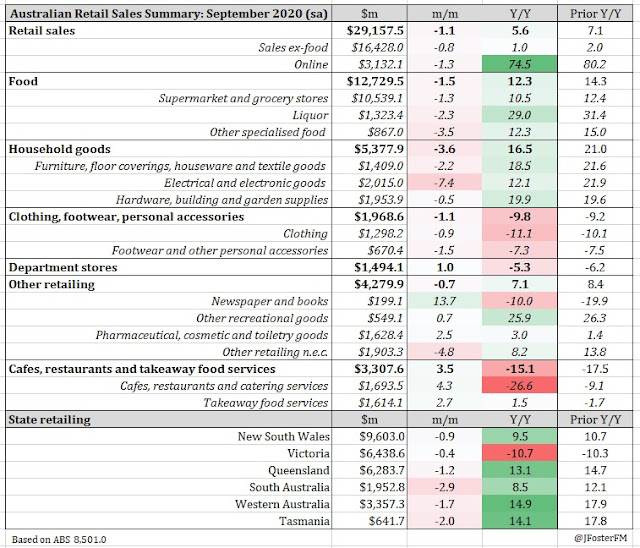Momentum in Australian retail sales softened for a second straight month as a 1.1% decline in turnover came through in September, though its level remains comfortably elevated on where it was pre-pandemic. Retail volumes rebounded sharply over the September quarter to more than recover Q2's shutdown-induced decline.
Retail Sales — September | By the numbers
- Nominal retail turnover declined by 1.1% for the month of September to $29.158bn, an upside result on the preliminary and market estimates of -1.5%, coming after a 4% fall in August. In annual terms, turnover growth slowed to a 5.6% pace from 7.1%.
- Retail volumes (nominal sales adjusted for inflation) surged over Q3 due to the reopening, rising by 6.5%q/q to come in above the median estimate of 6.0%, and this more than fully recovered Q2's shutdown-induced contraction of -3.5%. Annual growth in volumes lifted to 4.2% from -2.1%. Retail prices firmed by 0.5% in Q3 to be up by 3.8% through the year.
Retail Sales — September | The details
Momentum in Australian retail sales softened for a second consecutive month, with September's 1.1% decline following a 4% fall in August. The slowdown has been accentuated by Victoria's second shutdown, though turnover has softened across the other states over the past couple of months with earlier pent-up demand moderating, as shown in the chart, below.
Details from turnover in September point to signs of this moderation in pent-up demand with sales ex-basic food (as a proxy for discretionary spending) declining by 0.8%m/m after a 6.7% fall in August. The slowdown has been most pronounced in household goods (-3.6% in September and -6.0% in August) and clothing and footwear (-1.1% in September and -10.5% in August). However, there will be some reversal of these declines in October and November as Victoria opens up again.
It should be noted that even with the declines in August and September, retail sales are still running at a very elevated level, currently around 5% above their pre-pandemic level from February and this has been supported by significant fiscal and monetary stimulus as well as the boost generated by simply reopening again from the shutdown.
With the retail sector severely affected by the national shutdown, volumes had declined by 3.5% in Q2 (-2.1%Y/Y). The reopening and stimulus measures paved the way for a very strong return to trade in Q3 with volumes surging up by 6.5% (4.2%Y/Y), which more than made up for the decline in the previous quarter. Benefitting most from the reopening dynamics were clothing and footwear (36%q/q) and cafes and restaurants (28.1%q/q), though both remain lower over the year. Household goods surged in Q2 due to the impact of the shutdown (up 14.7%) but demand then steadied on the reopening (-0.2% in Q3).
The breadth of the rebound can be seen in this next chart, where the declines in volumes in Q2 were made to look small by the increases that occurred in most states in the September quarter. The only exception to this is in Victoria, which suffered back to back quarterly declines as the state was shuttered again after a second wave of the virus.
Retail prices continued to advance in Q3 but at a much more sedate pace of 0.5% compared to the previous two quarters. The key factor here has been in the food category, likely because discounting practices at the supermarkets have returned after it was largely shelved due to the intense period of demand that occured when households were stockpiling in preparation for the shutdown. The same would apply to the 'other' category as it includes items such as sanitisers, toiletry goods and pharmaceuticals. Household goods prices have risen sharply on strong demand for furniture to facilitate working and learning from home and for home entertainment equipment. Interestingly, cafe and restaurant prices fell in Q3, possibly as a result of competitive pressures in an attempt to entice customers back.
Retail Sales — September | Insights










